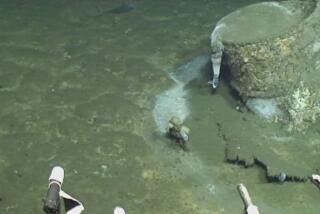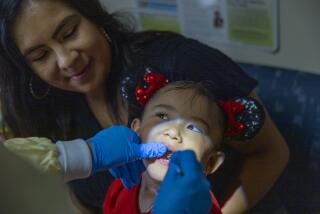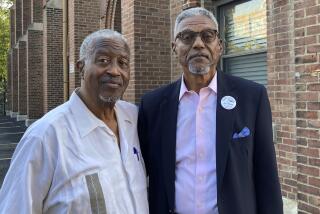Gauging Fallout From Baby Teeth
ST. LOUIS — The study was designed to stir alarm and did it ever succeed: As the U.S. tested nuclear bombs with scores of explosions in Nevada, researchers here--four states away in the nation’s heartland--found radioactive fallout in local kids’ teeth.
No one knew at the time how the radiation might affect the children’s health. No one attempted to find out. The study simply documented that as nuclear tests intensified through the late 1950s and early 1960s, kids were absorbing ever more radiation. Its goal was to help lobby for an end to above-ground tests.
The strategy worked. The St. Louis Baby Tooth Survey gained worldwide fame. Scientists collected nearly 300,000 teeth--most from the St. Louis area, a hot spot for fallout from the tests. And their findings helped build public pressure for the ban on atmospheric atom bomb tests that President Kennedy signed in 1963.
Now researchers hope to revive the tooth study--and the public activism it sparked--by exploring whether the fallout those Cold War kids absorbed has caused health problems over the years.
The follow-up is possible because of a chance discovery. Workers cleaning out an old ammunition bunker at Washington University here in May came across a cache of small envelopes secured with rusty paper clips. Inside were 85,000 baby teeth left over from the 1960s, each matched with a card identifying the donor.
The university was about to throw them out when a biology professor recommended donating the teeth to the Radiation and Public Health Project, a private research group in New York. Elated, scientists from the radiation project this month launched an effort to track down the donors so they can collect 40 years of health data.
Project director Jay M. Gould calls the opportunity “priceless.”
But the study’s splashy revival--featured on CNN, National Public Radio and in the St. Louis Post-Dispatch--has raised the hackles of some scientists.
“The short story? It’s unabashed junk science,” said Steve Musolino, a health physicist specializing in radiation at Brookhaven National Laboratory in New York. “It’s a study designed to scare people. It will never be able to reveal anything conclusive.”
Even the biologist who engineered the original tooth study has his doubts about the new project. “It’s going to be very difficult” to get any valid results, said Barry Commoner, now a professor at Queens College in New York. Not only that, the study will destroy the teeth, which Commoner would prefer to see preserved as a historical archive.
In objecting to the modern study, critics point out that there’s no way to compare the tooth donors’ health with that of contemporaries who did not absorb nuclear fallout. There’s also no way to measure other sources of radiation the donors may have been exposed to over the years--from medical procedures, perhaps.
Gould insists he will be able to draw valid conclusions. He plans to divide his subjects into three groups according to how much radioactive contamination is found in their decades-old teeth. He will then compare health statistics from each group to determine, for instance, whether those with the most contaminated teeth have suffered more cancer. “We might get a tremendous amount of information,” he said.
Musolino counters that any information gleaned will amount to “guilt by association,” nothing more.
It’s well established in scientific literature that exposure to radiation increases an individual’s risk of cancer. It’s equally well established that nuclear fallout sprinkled radiation around the globe.
But it’s almost impossible to extrapolate an individual’s exposure based on an analysis of his tooth. So while subject A may have twice as much of a contaminant in his teeth as subject B, it doesn’t mean he was exposed to twice the amount of fallout.
“If you wanted to design a study to measure how much cancer the fallout was causing, [analyzing] baby teeth would be the most ridiculous way you could go about it,” Musolino said.
Yet such criticism has been drowned out by a rush of enthusiasm for reviving the tooth study.
In the first five days after Gould went public with his plans, he received more than 1,000 e-mails from people who remember contributing their teeth and who are willing to answer health questionnaires. “The interest has been quite extraordinary,” Gould said. “We’re flabbergasted.”
One volunteer is 39-year-old Julie Fleck of St. Louis, who remembers that when she put her baby teeth under her pillow as a kid, the tooth fairy would leave her a quarter but would not take the tooth. “Our teeth are going to a study,” her mom would explain, “and our tooth fairy is smart enough to know that.” Fleck remembers too the buttons she got as a thank you for each donation. They featured a cartoon kid with a gap in his smile, and the boast: “I gave my tooth to science.”
Now a pediatric nurse, Fleck is thrilled to think her old teeth could help advance medical science. “Isn’t it amazing? What a way to have a long-term study.”
Her older brother, Doug Collinger, is also willing to participate, but he’s doubtful that strontium 90, the radioactive byproduct of nuclear fission, in his baby teeth can be linked to any specific health risk. “Considering all the other pollutants in the atmosphere, I’m not sure it was any worse than what we breathe today.”
The original Baby Tooth Survey was a groundbreaking effort. It marked one of the first times the public mobilized en masse to aid scientific research. The hoopla spread far; researchers received baby teeth from children around the world, some in envelopes addressed to “Tooth Fairy, St. Louis.”
Most teeth from remote locales were laid aside, however, to focus on kids from St. Louis. Though the bomb tests were conducted in Nevada, wind patterns pushed much of the byproducts here, where it fell to the ground with the rain. Animals grazing on that ground would absorb radioactive elements, which could be passed to people consuming local milk or meat.
The high levels of strontium 90 in St. Louis affected mostly fetuses, whose fast-growing bones and teeth readily absorbed any radioactive elements their mothers had ingested through contaminated food.
Thus, the Baby Tooth Survey found the levels of strontium 90 in kids’ teeth varied dramatically by birth year. Children born in 1950, when there had been just a few small-scale atom bomb tests, had barely perceptible levels of the element in their teeth. By 1957, when powerful hydrogen bomb tests were underway, they averaged 2.6 picocuries of strontium 90 per gram of dental calcium.
That ratio more than quadrupled for babies born in 1964, when atmospheric testing had ceased but remnant fallout was at its peak over St. Louis, said Joseph Mangano, an epidemiologist with the radiation project.
Gould hopes he can use the cache of forgotten teeth to find out what those numbers really mean. Many donors are pulling for him to succeed.
“We really thought we were making a big contribution to science,” said Sandy Rosen, 69, who sent her four children’s baby teeth to the project. “We never forgot about it.”






